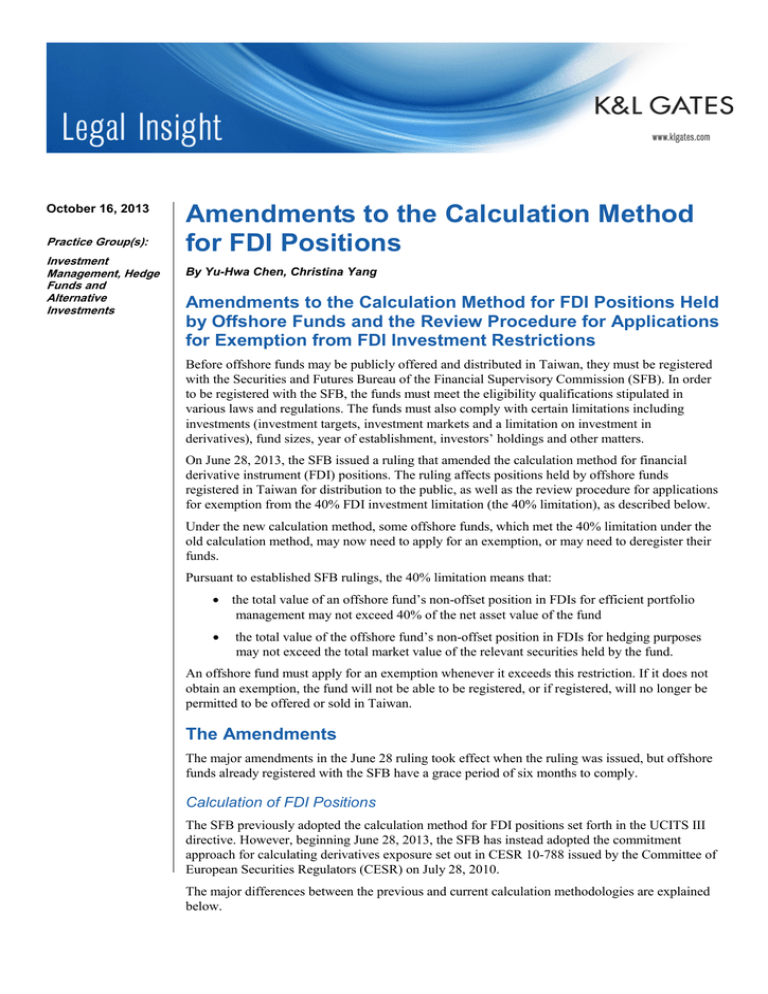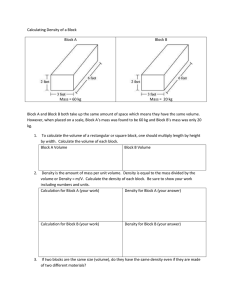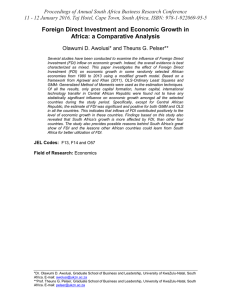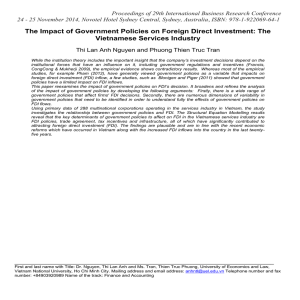
October 16, 2013
Practice Group(s):
Investment
Management, Hedge
Funds and
Alternative
Investments
Amendments to the Calculation Method
for FDI Positions
By Yu-Hwa Chen, Christina Yang
Amendments to the Calculation Method for FDI Positions Held
by Offshore Funds and the Review Procedure for Applications
for Exemption from FDI Investment Restrictions
Before offshore funds may be publicly offered and distributed in Taiwan, they must be registered
with the Securities and Futures Bureau of the Financial Supervisory Commission (SFB). In order
to be registered with the SFB, the funds must meet the eligibility qualifications stipulated in
various laws and regulations. The funds must also comply with certain limitations including
investments (investment targets, investment markets and a limitation on investment in
derivatives), fund sizes, year of establishment, investors’ holdings and other matters.
On June 28, 2013, the SFB issued a ruling that amended the calculation method for financial
derivative instrument (FDI) positions. The ruling affects positions held by offshore funds
registered in Taiwan for distribution to the public, as well as the review procedure for applications
for exemption from the 40% FDI investment limitation (the 40% limitation), as described below.
Under the new calculation method, some offshore funds, which met the 40% limitation under the
old calculation method, may now need to apply for an exemption, or may need to deregister their
funds.
Pursuant to established SFB rulings, the 40% limitation means that:
• the total value of an offshore fund’s non-offset position in FDIs for efficient portfolio
management may not exceed 40% of the net asset value of the fund
•
the total value of the offshore fund’s non-offset position in FDIs for hedging purposes
may not exceed the total market value of the relevant securities held by the fund.
An offshore fund must apply for an exemption whenever it exceeds this restriction. If it does not
obtain an exemption, the fund will not be able to be registered, or if registered, will no longer be
permitted to be offered or sold in Taiwan.
The Amendments
The major amendments in the June 28 ruling took effect when the ruling was issued, but offshore
funds already registered with the SFB have a grace period of six months to comply.
Calculation of FDI Positions
The SFB previously adopted the calculation method for FDI positions set forth in the UCITS III
directive. However, beginning June 28, 2013, the SFB has instead adopted the commitment
approach for calculating derivatives exposure set out in CESR 10-788 issued by the Committee of
European Securities Regulators (CESR) on July 28, 2010.
The major differences between the previous and current calculation methodologies are explained
below.
Amendments to the Calculation Method for FDI
Positions
Netting and Hedging Principles
• Hedging: According to the amended rule, hedging arrangements must comply with the
following criteria:
i) they must offset risks linked to fund assets (physicals or derivatives)
ii) investment strategies that aim to generate a return should not be considered hedging
arrangements
iii) there should be a verifiable reduction of risk at the fund level
iv) the risks linked to the FDI may be offset
v) the FDI and the hedged assets must relate to the same asset class
vi) they must achieve the purpose of hedging even in stressed market conditions.
These criteria are all new, except item (iii).
• Netting: Under the amended rule, an offshore fund may net the following non-offset positions
for efficient portfolio management, provided that the following netting principles are met:
i) between long and short positions of FDIs, the FDIs must refer to the same underlying
asset, although the maturity dates may be different
ii) between FDI and spot positions (the underlying asset of which is a transferable
security, a money market instrument or a fund), the underlying assets of the FDI and the
spot positions must be the same type of asset
iii) a fund that invests primarily in interest rate derivatives may make use of durationnetting rules to offset their positions, provided that the interest rate derivatives are not for
hedging purposes.
The amendment adds the duration netting and the netting between FDI and spot positions in items
(ii) and (iii). The closely connected price change between different underlying assets is no longer a
criterion for netting positions.
Formulas for Calculating Relevant FDIs
To illustrate the method of calculating FDI positions, the previous SFB ruling set out the
calculation formula for standard FDIs. However, after the amendment, in addition to the formula
for standard FDIs, formulas for calculating embedded FDIs and nonstandard (exotic) FDIs have
been added. In particular, convertible bonds are now included in embedded FDIs. The Funds
whose investment targets contain convertible bonds may be aware that, under such circumstances,
their investments in FDIs may much more easily exceed the 40% limitation.
The Valuation of Standard FDI Positions
According to the calculation formula for the FDIs described in the amendment, FDI positions, in
principle, are valued based on the market value of the equivalent positions in the underlying
assets. However, these FDIs may instead be valued based on the notional value or the contract
price if that method is more conservative. This position differs from the previous rule, under
which standard FDIs were valued based only on market value.
Because of the grace period noted above, existing offshore funds may use their current calculation
method until December 27, 2013. Applications for exemption from the 40% limitation should be
submitted to the SFB through the fund’s master agent before this date. Offshore funds which apply
for exemption may continue to follow their current calculation method until the SFB acts on their
applications. For full details of the new calculation method, please refer to June 28 ruling.
2
Amendments to the Calculation Method for FDI
Positions
Two-tiered Review Process
According to the June 28 ruling, an application for exemption from the 40% limitation must now
be reviewed first by the Securities Investment Trust & Consulting Association (SITCA) and then
by the SFB, not just by the SFB.
A SITCA officer will review the documentation and relevant data, and a task force committee
composed of professionals and scholars in the industry organized by SITCA will review the risk
management mechanism of the offshore fund. In principle, the committee will hold regular
monthly meetings to discuss exemption applications. After SITCA completes its review, it will
then transfer the application and its recommendation to the SFB for final review.
Authors:
Yu-Hwa Chen
yu-hwa.chen@klgates.com
+886.2.2326.5196
Christina Yang
christina.yang@klgates.com
+886.2.2326.5198
Anchorage Austin Beijing Berlin Boston Brisbane Brussels Charleston Charlotte Chicago Dallas Doha Dubai Fort Worth Frankfurt
Harrisburg Hong Kong Houston London Los Angeles Melbourne Miami Milan Moscow Newark New York Orange County Palo Alto
Paris Perth Pittsburgh Portland Raleigh Research Triangle Park San Diego San Francisco São Paulo Seattle Seoul Shanghai
Singapore Spokane Sydney Taipei Tokyo Warsaw Washington, D.C. Wilmington
K&L Gates practices out of 48 fully integrated offices located in the United States, Asia, Australia, Europe, the
Middle East and South America and represents leading global corporations, growth and middle-market
companies, capital markets participants and entrepreneurs in every major industry group as well as public
sector entities, educational institutions, philanthropic organizations and individuals. For more information
about K&L Gates or its locations, practices and registrations, visit www.klgates.com.
This publication is for informational purposes and does not contain or convey legal advice. The information herein should not be used or relied upon
in regard to any particular facts or circumstances without first consulting a lawyer.
©2013 K&L Gates LLP. All Rights Reserved
3






